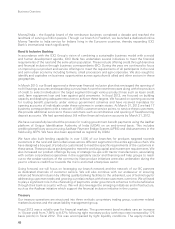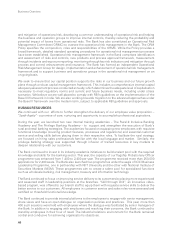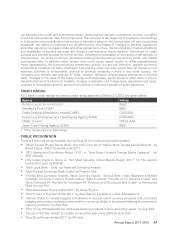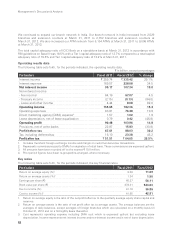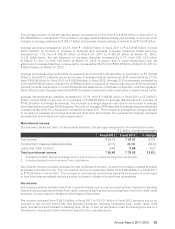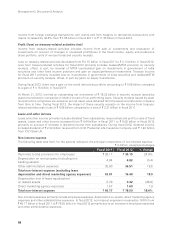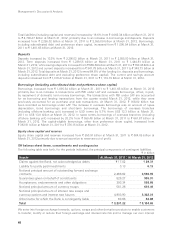ICICI Bank 2012 Annual Report Download - page 52
Download and view the complete annual report
Please find page 52 of the 2012 ICICI Bank annual report below. You can navigate through the pages in the report by either clicking on the pages listed below, or by using the keyword search tool below to find specific information within the annual report.50
the first year of upgradation from the earlier level of 0.25-1.0%. For the secured portion of assets classified
as doubtful, 25.0% provision was required to be made for assets that were classified as doubtful for a
year (earlier at 20%), 40.0% for assets that were classified as doubtful for one to three years (earlier at
30%) and 100.0% for assets classified as doubtful for more than three years. Further, for sub-standard
assets, a provision of 15.0% of the total outstanding was required with effect from May 2011. This was
an increase over the earlier requirement of 10.0%. Unsecured exposures, which were identified as sub-
standard, attract an additional provision of 10.0%, i.e., a total of 25.0% on the outstanding balance.
In May 2011, the report of the working group to draw up a roadmap for the introduction of holding
company structure was released with key recommendations favouring the financial holding company
structure for the financial sector, particularly large financial groups, with a separate regulatory framework
for these holding companies.
In August 2011, RBI released draft guidelines for licensing of new banks in the private sector. The
minimum capital requirement prescribed is ` 5.00 billion.
In October 2011, branch opening in tier 2 centres (centres with population of 50,000 to 99,999 as per
census 2001) was exempted from prior approval of RBI.
The all-in cost ceiling (over 6 month LIBOR) on external commercial borrowings of three years to five
years maturity was raised from 300 basis points to 350 basis points in November 2011. The all-in cost
ceiling (over 6 month LIBOR) for five years and above maturity was kept unchanged at 500 basis points.
Further, the all-in-cost ceiling (over 6 month LIBOR) for trade credit was enhanced from 200 basis points
to 350 basis points.
In November 2011, RBI issued prudential guidelines for single name credit default swaps on corporate
bonds. Banks were allowed to undertake such transactions, both as market makers as well as users.
In November 2011, RBI announced guidelines permitting the setting up of Infrastructure Debt Funds (IDF)
structured as non-banking finance companies (NBFC). Guidelines for banks sponsoring IDF-NBFC include
cap on equity holding of 49.0% of the IDF-NBFC, and investment not exceeding 10% of the bank’s paid-
up capital and reserves.
In December 2011, RBI announced the deregulation of interest rates on non-resident (external) rupee
deposits and ordinary non-resident accounts, thus permitting banks to determine the interest rate on
savings and term deposits of maturity of one year and above.
RBI issued guidelines on investments in subsidiaries and other companies, including investments in
non-financial services companies in December 2011. According to the guidelines, equity investments by
a bank in a subsidiary company or other financial services company cannot exceed 10% of the bank’s
paid-up share capital and reserves. Equity investment by banks in non-financial services companies was
capped at 10.0% of the investee company’s paid-up share capital. Equity investments in non-financial
services companies at the group level, including investments by the bank’s subsidiaries, cannot exceed
20% of the investee company’s paid-up share capital. Also, overall equity investments by a bank, including
investments in its subsidiaries and other companies, cannot exceed 20.0% of the bank’s paid-up share
capital and reserves.
In December 2011, draft guidelines for implementing the Basel III capital regulations were announced
by RBI. Further, in May 2012, final guidelines were issued as per which Indian banks would have to
maintain a minimum common equity tier I capital of 5.5%, a minimum tier 1 capital ratio of 7.0% of
risk weighted assets, a capital conservation buffer of 2.5% comprising only common equity capital and
a minimum overall capital adequacy ratio of 9.0%. The Basel III regulations would be implemented in
phases beginning from January 2013 and would be fully implemented by March 31, 2018.
In December 2011, RBI issued guidelines on the internal ratings based approach for calculation of capital
charge for credit risks. Banks intending to migrate to the Advanced Measurement Approach for operational
risk and internal ratings based approaches for credit risk are required to apply to RBI after April 1, 2012.
Microfinance institutions (MFIs) were brought under the regulatory ambit of RBI. Also, RBI decided to
give priority sector status to bank credit to MFIs extended on or after April 1, 2011 for on-lending for
specified purposes. In other related announcements, in December 2011, RBI decided to provide NBFC
Management’s Discussion & Analysis


